
BRITISH CAT MAGAZINES - A HISTORY
Since the beginning of the organised cat fancy, Britain has seen a number of magazines aimed at cat fanciers or pet cat owners or both at once. The fortunes of these periodicals has fluctuated depending on competition with other titles and on external events such as the World Wars, economic events and paper shortages. Some have being going for over 25 years and others barely lasted a year.
This page is restricted to the magazines available on news-stands and in newsagents, plus The Cat (Cats Protection) and the Feline Advisory Bureau (International Cat Care) quarterly journal as these are often available at cat shows.
THE LIVE STOCK JOURNAL AND FANCIER'S GAZETTE
This British publication began as "The Fancier's Gazette," but soon became "The Live Stock Journal and Fancier's Gazette" and should not be confused with the American poultry journal called "The Fanciers Gazette" (without an apostrophe).
NEW WEEKLY PAPER . . . THE FANCIER'S GAZETTE - North London News (and many others), 16th May 1874
New Weekly Paper, just commenced. Every Friday, price 2d. The Fancier's Gazette. Edited by Lewis Wright, author of the "Illustrated Book of Poultry," "The Practical Poultry Keeper," &c. A Journal for the Man of Leisure, the Professional Man, and for the Man of Business seeking Recreative Pursuits; and for all Ladies and Gentlemen, either in Town or Country, who exhibit or take interest in the Breeding and Management of Dogs, Poultry, Pigeons, Birds, Rabbits, Cats, and Pet Stock of any kind.

EXTRACT PROM PROSPECTUS. The title of the Journal now announced almost speaks for itself. It will he specially and in a sense in which so existing periodical can be said to be a FANCIER'S PAPER, whether his interest be in the most valuable animals which furnish investment and occupation to the opulent, or that recreation which is so invaluable to the professional man or the man of business, down to the smallest pets which provide amusement for a child. Thus, its main features will be The Kennel, the Poultry Yard, the Pigeon Loft, the Aviary, the Rabbit Hutch, and the Cat Show; but Pet Stock of every other description may find a corner in it, while Pedigree Animals of a larger growth will be spoken of whenever fitting. In a word, Pedigree Stock, Fancy Stook, Pet Stock these will be its subject matter.
These various subjects will be treated more particularly from a Breeder's and Exhibitor's point of view; and will be so treated more fully and more thoroughly than has ever yet been done. The Publishers and Editor believe that there is both room and demand for such a special organ, which shall be able more fully and thoroughly to embrace all those topics; and that in providing it they will find a field of their own, without detriment to any other ground already occupied. In doing this they propose, as opportunity offers, to show the bearing of certain of their departments - such as Poultry and Rabbit Breeding - upon the food of the nation, and how the production of such food can be increased and encouraged. They hope also to make both the principles and practice of good Breeding better understood, and so to raise even higher that high standard of merit which has already made Britain the source of high-class stock for the whole world.
Hence a main feature of this Journal will be its full Reports of Exhibitions by disinterested [impartial] and independent writers, to secure which special arrangements will he made. It is also proposed to provide in the FANCIER'S GAZETTE a pleasant medium for intercourse and discussion on points of interest. The space at command will allow of fuller discussion in the shape of correspondence than other papers can afford, and Fanciers are heartily invited to avail themselves of it. Illustrations will be employed whenever they can serve any useful purpose, or exemplify any unusual degree of excellence; but never merely to please or advertise any individual breeder. Approved Advertisements will be inserted in THE FANCIER'S GAZETTE, terms for which can be obtained on application to the Manager, Advertising Department, La Belle Sauvage Yard, Ludgate Hill.
This is an example of a contribution to the journal, from a September 1875 edition of the "Live Stock Journal and Fancier's Gazette."
"SAGACITY OF CATS." Everybody knows that cats can open doors if left off the latch, and also that they soon get up to the mechanism of the old-fashioned hand-and-thumb latch; they open this by springing up, and holding on to the hand portion with one arm, while they press down the thumb portion with the other foot. A lady friend of mine has a large tabby Tom who can open a room door by standing on his hind legs and turning the knob with his teeth. This is clever, but cats even know how to fasten doors, at least some do and this same lady was once in a cupboard, when one of her pussies came and turned on the button latch of the door, and made her a prisoner for some considerable time. In a small village which I know there is an old woman who lives by keeping lodgers of the more humble description. As these have often to get up and be off early in the morning, the woman always gives them strict injunctions to shut the door when they go out, for fear of thieves. One morning a lodger had forgotten to obey his landlady's instructions. Pussy, however, had witnessed the infraction of the rule, and walked directly to her mistress's bedside, and began to mew most plaintively. Nor would she be content till the woman got up, when the cat led her directly to the door. Pussy wouldn't go out, but so soon as the door was shut, led the way again back to bed, singing. Old women's cats are nearly always wiser than others- they get more care taken with their training, and more comfort and love. They know all the ways, likes and dislikes, of a beloved mistress, and study them, just as they do their own. Indeed, some of the things I have known old women's cats do are unaccountable in any other way but the belief that they are possessed of a very high amount of intelligence and reasoning power. No wonder our ignorant ancestors believed them possessed of devils.
THE COUNTRY JOURNAL
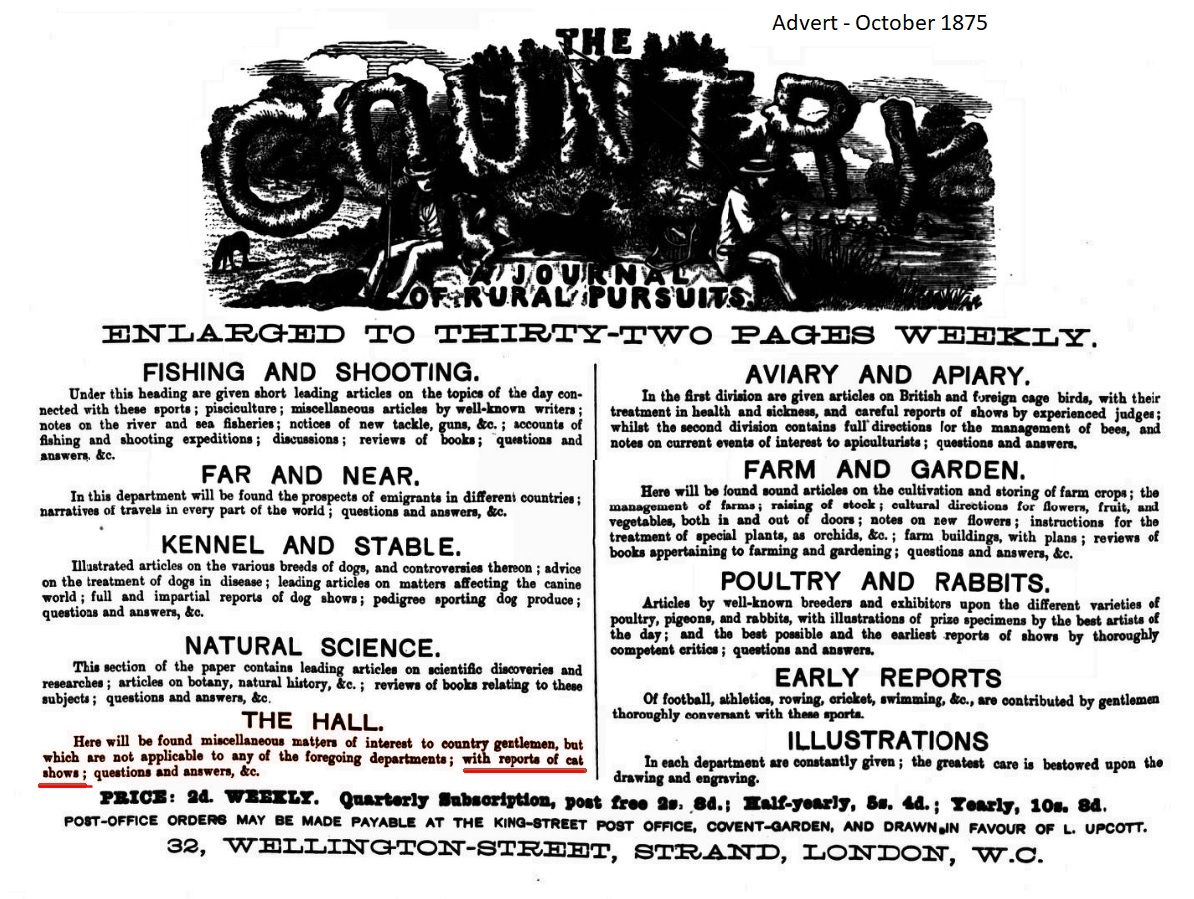
FUR & FEATHER
In the 1800s, Fur & Feather was the main magazine of the organised animal fancy. As its name suggests, at that time it covered all the different fancy animals being bred and exhibited. It was informative, authoritative and full of the latest news, views and show reports. As time went on, species-specific magazines appeared and show reports appeared in those specialist publications instead. Cat fanciers got their dedicated publication in the form of Our Cats towards the end of 1899; a periodical that was deliberately given the same title as Harrison Weir's book.
With much time on their hands, breeders and exhibitors wrote at length and carried on conversations and disagreements from issue to issue. I find it fascinating to read some of these lengthy treatises from privileged ladies and step back into the Victorian and Edwardian eras.
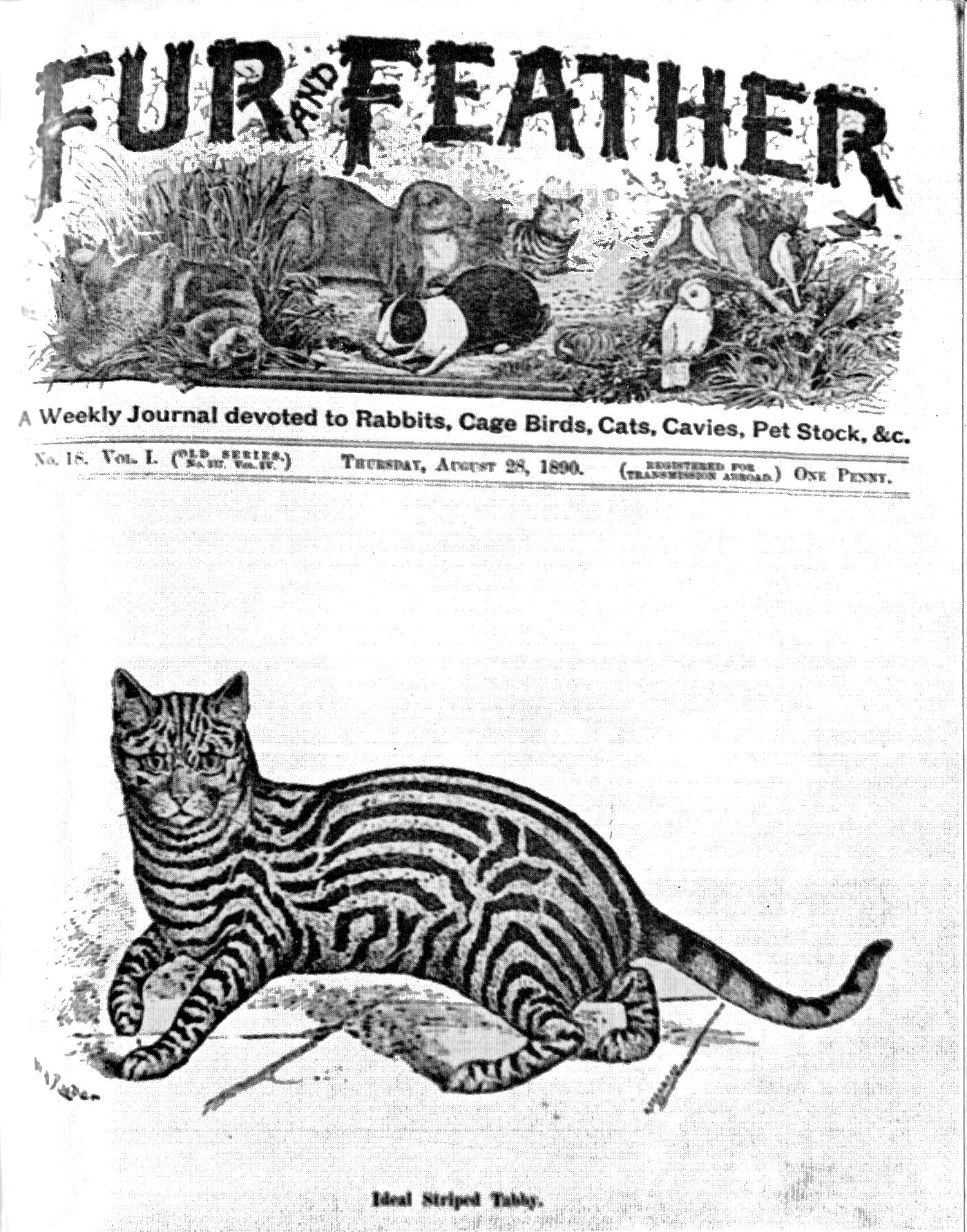
Fur & Feather was published by J.E. Watmough of Idle, Bradford from 1890 to 1981. In 1890, the small printing works at Idle, Bradford produced it as an illustrated weekly magazine priced at one penny and dedicated to the hobbyist or fancier. The editor was J.E. Watmough who was eager to include the cat fancy. His first editorial read: "To my friends past and present, I now place in the hands of my readers the first edition of Fur and Feather,' with which is incorporated our little friend Small Pets.' Today it goes forth on its mission in the interests of those who are engaged in certainly some of the most pleasurable, instructive and entertaining of pursuits, and which are calculated, if properly followed, to normally elevate, and affect considerable social reform. The columns of Fur and Feather' are open to all who wish to discuss matters affecting their hobby. My sole aim is to publish beneficial advice and everything that is of genuine interest to the Fur and Feather brotherhood."
At first, individual cat fanciers seemed shy of self-publicity, but cat clubs took up the invitation to publicize their hobby. Cats were sometimes exhibited at poultry shows, agricultural shows and fur and feather' shows (rabbits, cavies, mice, cagebirds, poultry etc) and judged by an all-round judge (almost always a man) whose reports covered all the livestock and often the horticultural exhibits too! The National Cat Club, whose acting secretary was J. W. Townsend began submitting weekly articles. Harrison Weir, the Club's president, encouraged National Cat Club officials to report on their meet ings. In 1890, Fur and Feather published a report on a cat show held in Kew Gardens (unfortunately for cat fancy historian, only the owners' names were published at that time, not the cats' names).
Individual fanciers still remained aloof, so the Editor wrote the following letter to Mrs Herring, and also published it in the magazine: "We should be very glad if our catty friends would contribute particulars of their doings in the feline world. There is no section of the Fancy more influential, more devoted and enthusiastic, yet they have less to say. We again offer our pages in Fur and Feather and trust they will no longer be reticent." This time cat fanciers responded positively and submitted articles for publication; these articles were useful to other fanciers and valuable in recording activities of the cat fancy. Fur and Feather recorded the formation of cat clubs and helped develop the cat fancy, making "fancy cats" desirable and cat shows popular. Long-haired breeders predominated and the editor described them as "the most loyal and non-critical of fanciers." (Later on, much "cattiness" would appear!) Breeders also submitted "At Stud" and "For Sale" notices. Mr. Townsend reviewed Mrs Kinchant's book: "Cats for Pleasure and Profit," and wrote, "This little book is practical to a degree. All fanciers should have it in their possession. Surely none would grudge the necessary sixpence to acquire such a valuable book!"

During the "Great War," it concentrated on breeding poultry and rabbits for the table, but after the war it was reinvigorated, increased in price to tuppence and, in August 1919 it announced "Hurray, Hurray! Sandy Show. First Post-War Championship Show." Articles by Miss Frances Simpson (Long-Hairs) and Mr T. B. Mason (Short-Hairs) were published on alternate weeks and Miss Savory revived the Midland Counties Cat Club. The Fancy was again alive and growing daily. At the time other magazines Bzaar and Exchange and Our Pets also reported on cats and cat shows, but being non-specialist their reports were less satisfactory to cat fanciers.
At a meeting of the Governing Council of the Cat Fancy at Anderson Hotel, Fleet Street, 7th July, 1919, "Fur and Feather" was unanimously voted an official organ Governing Council. Present at that meeting were Mrs Kennaway (National Cat Club), Miss Lea (Red Cream and Tortoiseshell Society), Mrs Robinson (Siamese Cat Club), Miss Frances Simpson (Blue Persian Society), Mrs Stephen (Southern Counties Cat Club), Miss Wood, (Chinchilla and Silver Smoke Society), F. W. Western (Southern Counties Cat Club). Miss Simpson chaired the meeting in the absence of Lady Decies. The GCCF published this notice in the next issue of Fur and Feather: "GOVERNING COUNCIL ORGAN. Our catty friends will be pleased to learn, from the report of the meeting of the Governing Council of the Cat Fancy, held on the 7th July, which appears in this issue, that Fur and Feather has been made the official organ of the Cat Fancy. This will mean, of course, that Fur and Feather will be the paper which gives the official news and current doing of the Governing Council and registrations will be published in these columns. Fur and Feather will thus be the most up-to-date paper devoted to cats and no cat lover can afford to be without it. Now that there is a prospect of shows being held again, the Cat Fancy is bound to be infused with new life and new vigour and we hope to see a great revival of interest and enthusiasm. We will endeavour to do our part towards bringing this about by giving to the Cat Fancy some really in teresting and topical news, and we trust that cat lovers will help by sending in for publication any interesting items which come their way."
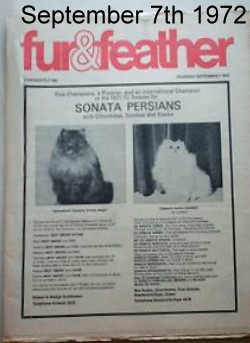
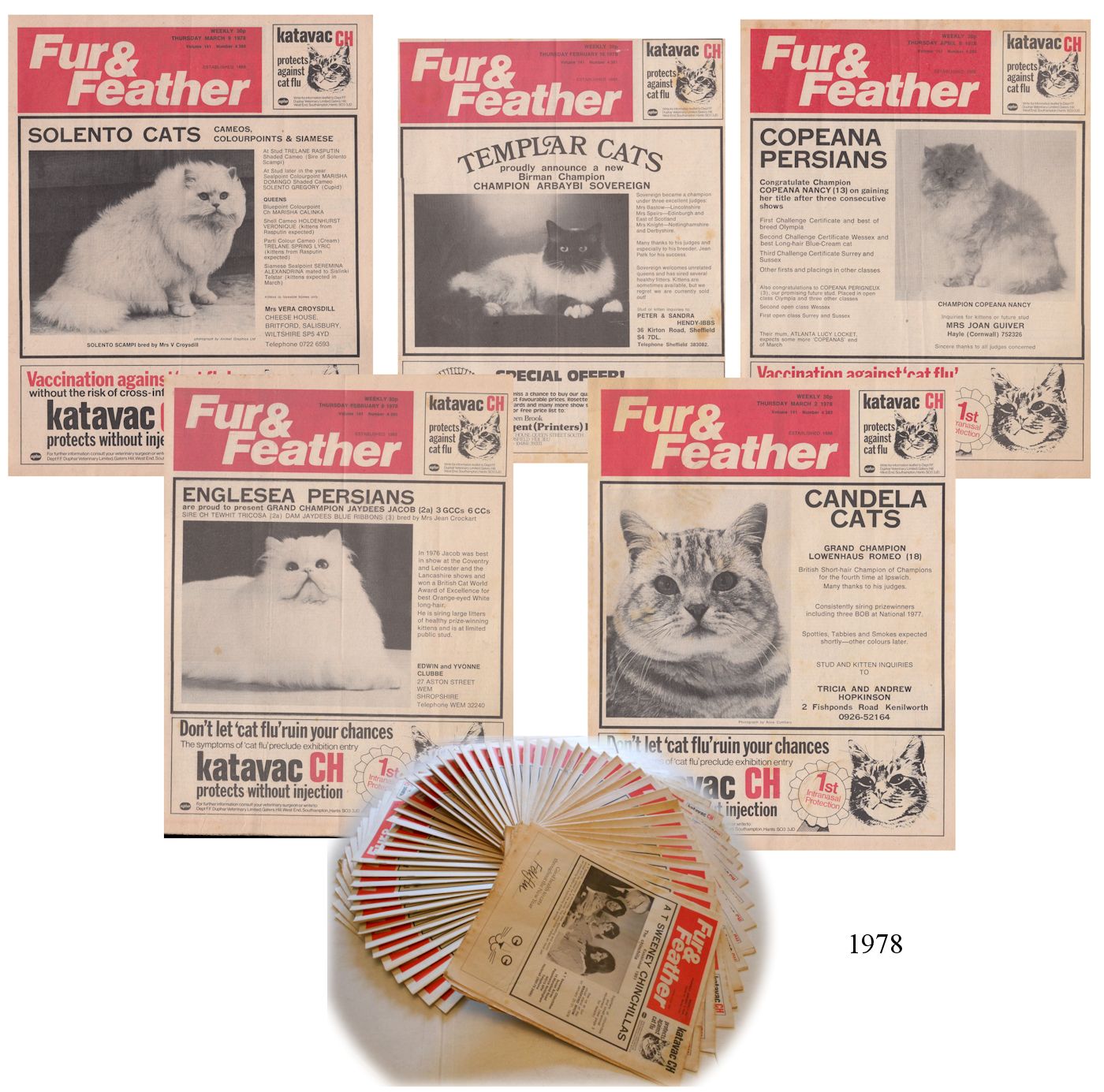
In 1898, "The Show Reporter", published by George A Townsend of Leeds, appeared and began to attract many of the top fanciers of the period as contributors. Townsend was the editor and appears to have paid his correspondents a small fee for their regular columns and news updates. Although it was only published for a year, "The Show Reporter" was very successful and this shook up Fur & Feather who were losing readers to the new magazine. Fur & Feather changed its policies and won back some of the readers who had defected. After 18 months, Townsend decided to discontinue "The Show Reporter" due to falling sales. He was a businessman and decided that his magazine was no longer viable. It ceased publication on 21st December 1899. Fur & Feather's other rivals were "Our Cats" (November 1899 until July 1913) and "The Bazaar" (1920s).
In early 1981, Fur & Feather split into two new magazines "Cats" and "Rabbits". For many years, Fur & Feather was THE magazine for animal fanciers and though there were other fanciers' magazines available, they were very much minor players. Fur & Feather exhibited a rather superior attitude which did not appeal to all fanciers. By the end of the 20th century, it had become dedicated to the breeding and exhibiting of small caged mammals. Although its focus has changed, it is good to see the Fur & Feather name still continues.
THE LADIES KENNEL JOURNAL
This was the publication of the Ladies' Kennel Association, the first incarnation of which was founded in 1895. Its secretary, and the publisher of the Ladies' Kennel Journal was Mrs Alice Stennard Robinson. The journal also included the cat fancy in its pages. Mrs Stennard Robinson was also a major figure in the cat fancy, becoming Secretary and Treasurer of the National Cat Club after the resignation of Harrison Weir. It carried reports from cat shows and articles on notable fanciers and their catteries.
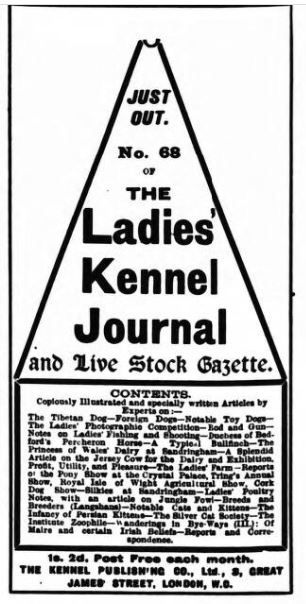
Another animal fancy journal was Lady Exhibitor.
THE LADIES FIELD
The Ladies' Field began in 1898 and was published by George Newnes. In 1928, it was absorbed by "The Home Magazine" (founded in 1893 as "The Woman at Home"). The name suggests a female-oriented sporting magazine equivalent to "The Field" with articles such as "The Irish Hunting Season." It was a middle-class-oriented magazine and in addition there were pages on fashion/clothing, e.g. tweed jackets, and gossip such as celebrity news and events. The magzine had several pages devoted to dogs and to prizewinning cats; breeding and showing these were acceptable pursuits for women.
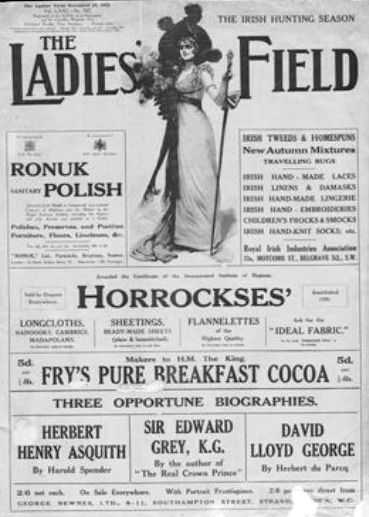
Here is a sample of "Cat Gossip" from "The Ladies' Field" in 1910. It's very useful for tracking changes in ownership of cats and deaths of notable cats and communicating to stud cat owners the birth of kittens to queens sent to their stud cats. The column was penned by "Dick Whittington" (Miss (or Mrs?) Higgins) whose work is overshadowed by that of Frances Simpson, but who deserves to be better known. Mr W. Summerfield has just purchased from Miss Alianora Chevers the pale blue Persian kitten, Ulster Blue Bellairs, a son of Kew Blue Peter and Ulster Blue Bellarina. This kitten is of a beautiful pale blue colour, with lovely orange eyes and good coat. Mrs Campbell Fraser's Withdean Blue Pearl his six pure blue kittens by owner's Blue Peru of Hessie, born October 7. Miss Miller's Cindy has six kitten's by Miss H. Lea's Ruckholt Blue Laddie. Mrs Dougan's Falls Fairy has three kittens by Mr J. Flitt's Silvester. Mrs Chilcott has just had the misfortune to lose her Siamese cat, Hiraja, from pneumonia.
The Ladies Field Club was described in an article from The Chicago Tribune, November 29, 1903: LONDON has a score of woman's clubs as elaborate and complete in their appointments as any of the masculine clubs in Chicago [. . .] The Lady Decies Chief Organizer of The Ladies Field Club. [. . .] Rooms for Cats and Dogs. Next in size and Importance [after the Empress Club] comes the Ladies' Field, also in Dover street. Its membership is about 500, being of women who are or profess to be interested in some athletic and out-door exercise. To quote its prospectus, "The Ladies' Field club has been established for the use and benefit of country gentlemen's wives and daughters, and of ladies Interested in all kinds of country sports, pursuits, and pastimes." The committee is formed almost entirely of titled women, of whom Lady Decies is the moving spirit. Its most striking feature and its most ridiculous consists In the apportioning off of two rooms tastefully furnished and beautifully upholstered "for the convenience of members' cats and dogs respectively." For them "board and lodging" is charged at the rate of 2d (4 cents) per two hours and 1 shilling (24 cents) a day. It Is of course an absurd concession to the fanciful craze of the moment which makes it a necessity for a woman of fashion to be always burdened with one or the other of these "pampered pets." A more useful specialty is a room devoted to fencing, where an expert master is always prepared, but seldom called upon, to give the members lessons. Billiard rooms are also in evidence.
LADY'S PICTORIAL
Another magazine that carried cat show reports was "Lady's Pictorial," running from 1880 as a monthly, changing to a weekly in 1881 and merging with “Eve” in 1921. It was "a newspaper for the home" aimed at a relatively affluent middle-class audience. Cats and Cat Shows were a hobby and social event.
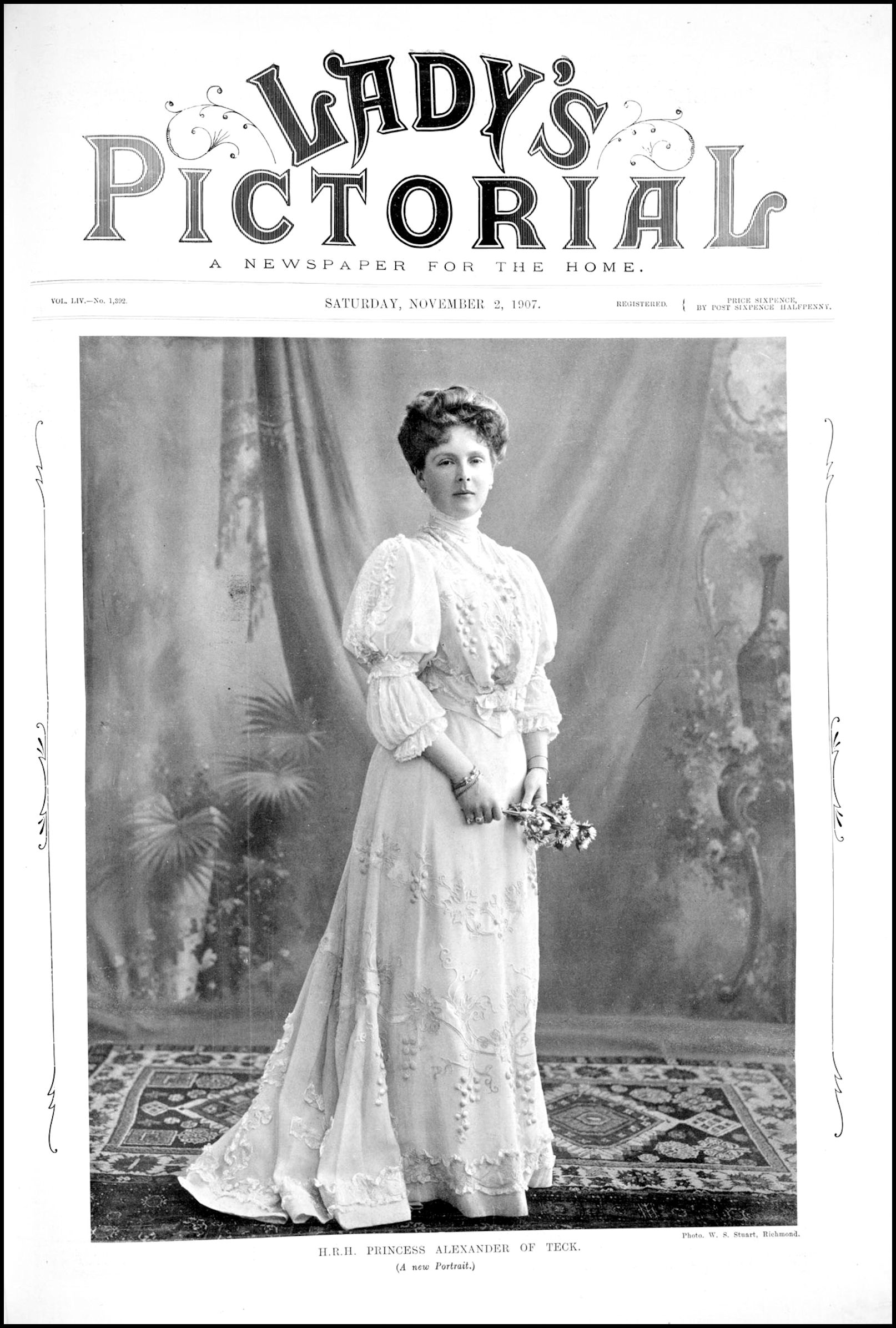
OUR CATS & CATS
Since 1899, there has been more than one publication using the name Our Cats and though they are not directly related, they are all detailed in this section. "Our Cats" was the title of Harrison Weir's book that recorded the first breed standards, so it's not surprising that the name has been used several times by cat fancier magazines. Being wholly dedicated to cats, and lacking mass appeal, "Our Cats" often struggled
The first magazine to bear the name "Our Cats" was published at the very end of the nineteenth century. The first issue of the weekly magazine Our Cats was published November 1st 1899 and this issue through to the July 13 1900 issue are in the British Newspaper Library collection. Its content at that time was devoted to reporting on cat shows and associated mattered (breeding, exhibiting etc) and contained many letters to the editor and articles debating issues of the time. The cat fancy at that time was mainly the preserve of the well-off, and numerous aristocratic ladies took up the genteel hobby of cat fancying. Judging, however, was often a male preserve. Compared to the succinct content modern letters pages, the letters at that time were often long treatises.
"THE special Christmas Number of Our Cats is an excellent production, appealing forcibly to lovers of this favourite domestic animal. The supplement, consisting of portraits of a number of well-known prize-winners, should prove particularly acceptable. " The Gentlewoman, 29th December 1900
Our Cats was initially published in London, later moving to Manchester and then to Cheshire where the editor and owner was Mrs Herbert Ransome. Printed on pink paper, it began as a small square journal and then grew to a tabloid. As well as show results and reviews, there were reports about cat rescue work and advice on cat care. The children's page had to be dropped because children inevitably read the more adult sections of the magazine - i.e. breeding, neutering (or rather the resistance to it) and euthanasia.
In February 1903, "Our Cats" increased in size and the price increased to twopence. In the following month, the colour of its pages changed from pink to white. In 1909, "Our Cats" was still a two-penny weekly and was edited by Miss Sansome of Bowden, Altrincham.
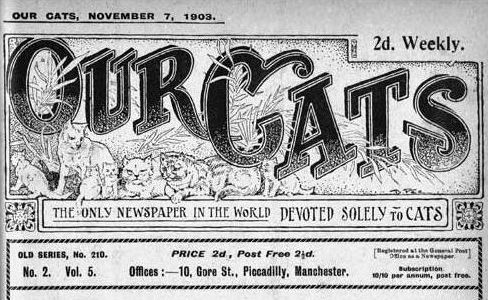
Somewhat later, Our Cats became a monthly publication, but still reported on cat shows and specific cats. It began to include more articles about breeding practices, veterinary advances and a focus on scientific breeding (early genetics), but never lost the feel of being a "club magazine". In July 1913, the deadline for advertising was printed as normal, but the magazine was not published.
In 1949, a new incarnation of "Our Cats" appeared, this time edited by Arthur Cowlishaw. Under the management of Arthur E. Cowlishaw, its photo s, accounts of club affairs, articles by foremost breeders and its attractive lay-out made it esteemed by discerning fanciers. It was also sold abroad and was a link between breeders and cat lovers of other lands. This magazine was a pocket-sized paper and among its contents were celebrities and their cats; veterinary advice columns, and articles by contributors in North America, Europe and Australia. It also covered the arrival of a number of new breeds being developed in Britain or arriving from the USA. Our Cats was available to American readers, with yearly subscriptions of $3.50 being handled by Charles A Kenny of "Cats Magazine". Subscribers were reminded to clearly indicate that the remittance was for the English magazine "Our Cats". In return, English readers were invited to subscribe to "Cats Magazine". To reduce costs, especially the cost of producing unsold issues returned by newsagents, it became a subscription-only magazine after 1956 (as a result, there was noticeable drop-off in advertising from Chappie Ltd who produced Kit-E-Kat). Being a journalist as well as a cat fancier, Arthur Cowlishaw knew how to do things well. He registered the magazine, made it an official publication described as an illustrated journal for the entertainment and instruction of breeders and cat lovers. It survived 17 years, ending in 1966 when Arthur Cowlishaw died and the magazine was wound up.
Around 1969/70, "Cats," published every two months, was an entirely new magazine devoted to the interests of cat lovers and was described as well produced.
"Cats" (not to be confused with a now-discontinued US monthly of the same name) was, for many years, a weekly magazine that also served as the official journal of the UK's main cat registry, the GCCF. "Cats" was launched as a monthly magazine in April 1981 when "Fur & Feather" split into two magazines: "Cats" and "Rabbits". "Cats" described itself as a specialist magazine for owners, breeders and exhibitors and much of it was devoted to show results, judges' reports, show dates, registry news and club news. As such, it was a niche publication and usually of little interest to cat owners that didn't breed or exhibit. Its December "Annuals" carried more articles.
"Cats and Catdom" was the Annual for the cat section of "Fur & Feather", running from 1972 to 1983, minus the 1981 Annual which was not produced because the publishers were setting up "Cats" as a weekly magazine in its own right. In 1982 and 1983, the Annual was called Cats and Catdom before being renamed "Cats".
Here is how "Cats" described itself in its August 1981 issue (Issue 5): "Due to the launching of Cats this year it was not possible to produce a 1981 Cats & Catdom Annual'. But, following hundreds of requests from all over the world, the December issue of Cats will be a truly bumper edition, including a special supplement incorporating all that was valued in the Cats & Catdom Annuals'. There will be lots of articles and a special opportunity for breeders to advertise as they used to do in the Annual. And the rates will be the same as Cats breeders feature advertisements. What superb Christmas reading this will give, and what a marvellous present for a friend! Following close on the heels of this will be another bumper January issue. This will include the Champion Supplement made famous in Fur & Feather.' Cats,' on sale at newsagents and by subscription, is well established at home and abroad where breeders will eagerly be making sure that they receive their December and January super Cats. . . . Full details of both will be published in September Cats. And more good news is that the cover price of these extra-special. Cats will remain at 1.50! Remember, PEOPLE WHO KEEP CATS, KEEP Cats."
" 'A treasure for the future' On behalf of the cat Fancy I would like to propose a very sincere vote of thanks to the editors, writers and printers of Fur & Feather' for their Cat Section over so many, many years in the past. Their section was excellent with what space they had and we owe them so much for such a long and dedicated service. It is mentioned in France Simpson's book printed in 1911, "I may here mention the chief organs of the cat world in England are Fur & Feather' and Our Cats.'" For many years, recently, we have had other cat magazines, when alas! Our Cat' ended, but none have succeeded for long. The GCCF also have been trying to get a cat Fancy book or magazine and now thanks once more to the editors, printers and writers we have Cats.' Cats' is a really superb magazine with each show fully recorded (most useful I find checking my miscellaneous classes judging with the open classes!) also a magazine one can read at leisure and not have to cram into a week before the next issue appears. It really is a beautiful magazine that one can treasure for the cat Fancy of the future.
BACK NUMBERS! People who keep cats, keep Cats. Did you miss any of the first issues? Copies of all back numbers are available at 2. ALSO A LIMITED NUMBER OF CATS & CATDOM ANNUALS
1978 - 1-75. 1979 - 2-00. 1980 - 2-50.
Now that several issues of Cats have appeared in print, one can say with confidence that the attitude of the cat Fancy to its Official Journal, in its bright new format, is decidedly favourable.
Inevitably, a monthly magazine has one or two inherent disadvantages when compared with a weekly publication. Some of these disadvantages are more apparent than real. For example, many people expect an even greater delay between shows and the appearance of the judges' results than used to occur in the Fur & Feather' days. This is unlikely to be the case because we now have a much greater space available to us, with the result that the appearance of show results should not be more delayed than before. A corresponding advantage is that the whole magazine is devoted to cats; and we are therefore getting three or four times the value for our money than we got previously.
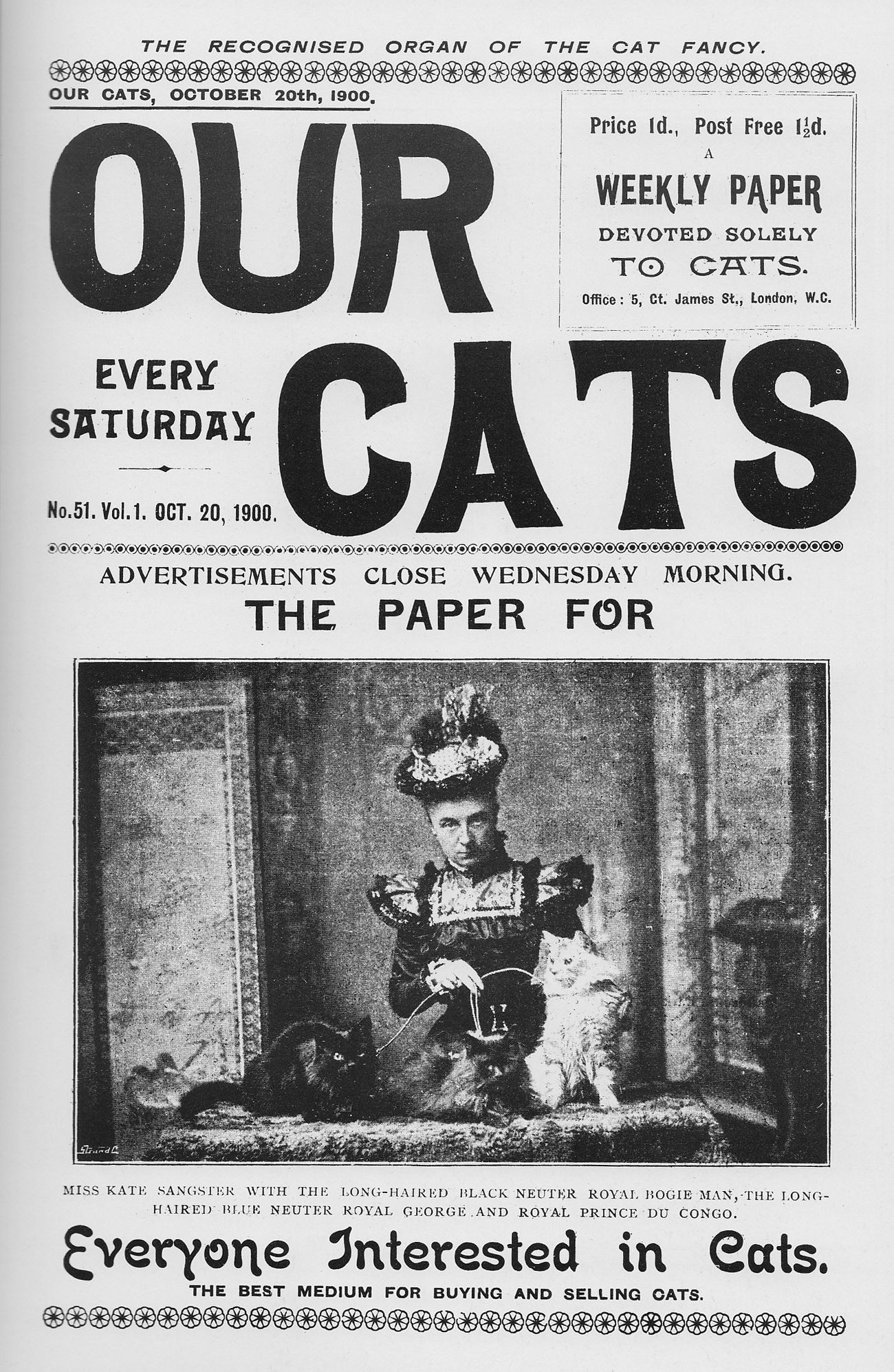
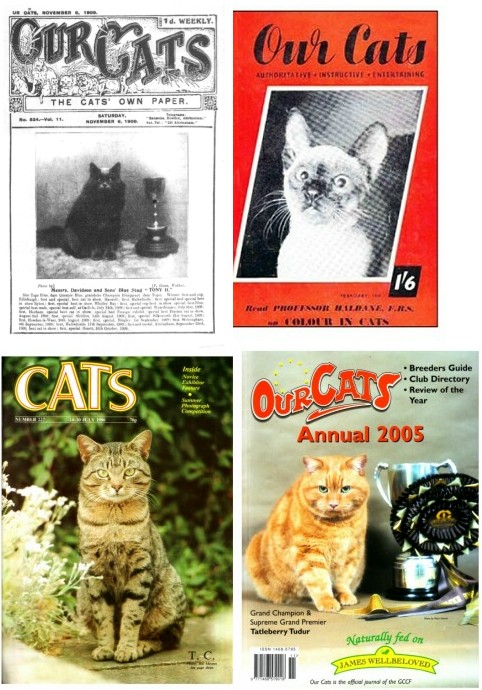
Early in the 2000s, the ailing Cats re-branded and re-launched as "Our Cats", resurrecting the title of that earliest cat fancy magazine. However it was still aiming at the existing breeder-exhibitor audience and carried nothing to widen its appeal beyond that audience. During 2009, Our Cats (produced by Axis Cook Media) ceased being published and is no longer the GCCF's official journal. As a small, niche publication facing competition from the internet (which could supply show results much faster), it could not survive on subscriptions alone. Although the GCCF served a Breach of Contract on the publisher in March 2009, they did not get sufficient advertising revenue to maintain production and received little (if any) GCCF funding despite devoting 28 of its 32 pages to the GCCF. It was unable to sustain these losses and publication ended.
Very few newsagents carried Cats or the Cats Annual. I used to pick up the Annual and some magazine copies at the National and Supreme Cat Shows. It was intermittently available at larger WH Smith stores; I sometimes found it as an uncollected subscription copy being sold off by my local branch.
CAT GOSSIP
Cat Gossip began on December 8th 1926 as a 6-page privately produced weekly edited by H C Brooke. As the title indicates, it was mostly snippets and contributions from correspondents. It reported interesting developments and discoveries as well as the sometimes unusual theories and opinions of its correspondents.
Its editor, HC Brooke, was involved with a number of animal fancies and seemed to collect rare or unusual breeds.
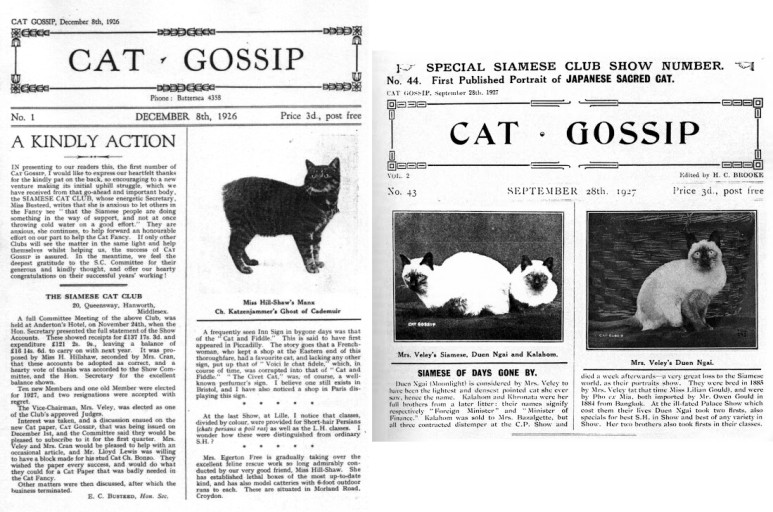
CATS AND KITTENS
This title has also been used for several magazines and I believe there is currently a "Cats and Kittens" magazine published in North America.
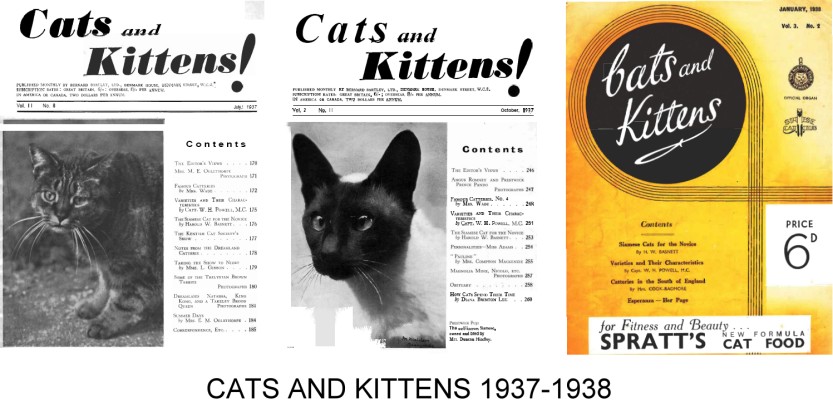
In the early 1930s, the 48-page monthly Cats and Kittens appeared. It was edited by Arthur A Prestwich and based in Horsham, Sussex. Topics included the Paris Show; the problem of infectious diseases and the usefulness of vaccinating cats against those diseases. Welfare and cruelty were of concern to the readers. Another interesting topic was cats owned by celebrities, especially by film stars (incidentally, film star James Mason would later write a cat care book). Within a few years, Cats and Kittens was absorbed by the weekly Cat World and for a while was titled "Cat World and Cats and Kittens".
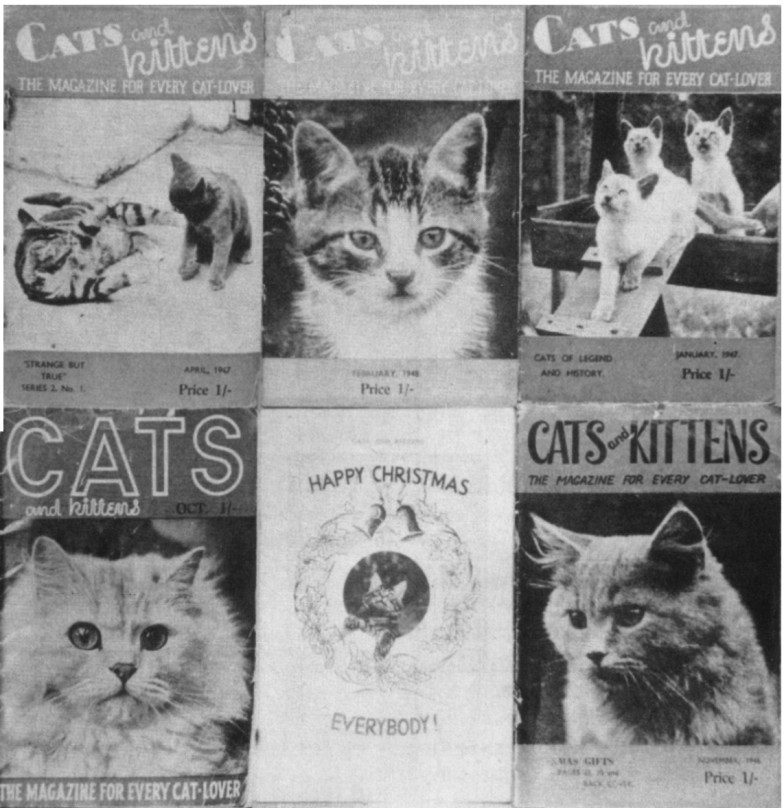
In 1944, a new monthly Cats and Kittens magazine "The Magazine For Every Cat Lover" appeared and was published by Mr and Mrs Sydney France. Though breeding was a always a popular topic, it also catered for a more general audience. It had a monthly feature from the USA. The Cats Protection League also featured in its pages. It ceased publication with the July 1956 issue. It appears that the illness of Mr. France in 1954 made him contemplate the magazine's long-term future. The ever rising costs of production and distribution made it "a labour of love," so regretfully he decided to call time on the publication.
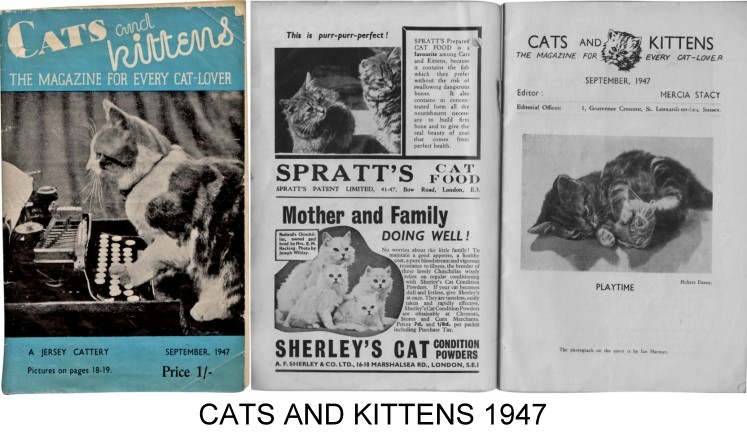
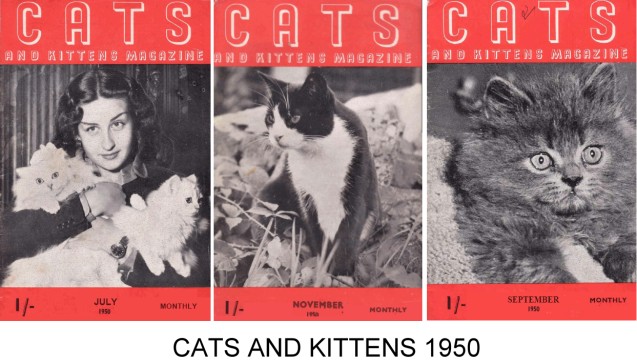
THE CAT FANCY
Launched in 1947, "The Cat Fancy" was a monthly journal devoted entirely to pedigree cats. it included judges' full reports from cat shows, breeders' news, club reports and meeting dates and articles about the cat fancy overseas. Naturally it advertised studs and sales. It cost 7d for a single issue or 7 shillings for a year's subscription and was obtainable only from The Editor, Kit Wilson, based in Kensington, London.
THE CAT BREEDER
A magazine called "The Cat Breeder" (late 1960s?) was sponsored by Petfoods Ltd and initially offered free to breeders had powerful commercial backing, but vanished.
THE CAT LOVER'S JOURNAL
The annual Cat Lovers' Journal (circulation around 12,000) began in 1966 and described itself as the Year Book of the British Cat World. It was published in the summer by Cats Accessories Limited, 1 Newnham Street, Bedford MK40 3JR, England, and was printed by Reliance Printing Works, Birmingham Street, Halesowen, Worcs. This annual magazine carried a mix of breed articles, stories, poems, show reports, photos, general interest articles and advertising. In the 1960s and 1970s, when few people travelled abroad for their summer holidays, summer annuals/summer specials were printed. It was also available in North America, but not in New Zealand or Australia.
The Cat Lovers' Journal claimed to be the best medium in the country in which to advertise Breeder's Stock and Commercial Products for or about Cats. If a breeder had a very successful cat on the Show bench at any particular Show, s/he was invited to write in and tell the Show reporters, who tried to cover the whole scene but could not always visit every Show during the season. They also tried to feature one or two Cat Charities in each issue. They did not confine their articles and stories to Great Britain. Editions also featured a Cat Sanctuary on the Canals in Amsterdam.
In 1973, the "Boarding Cattery" section was been made into a new annual publication, "Cat Boarding" and it was planned to publish this in the spring, ready for the summer holiday season. The Journal was published later in the year owing to the difficulty of getting in the Show reports at the end of each Show season. There's little information available on this publication; its start date was gleaned from a comment in the editorial section of the 1971 edition.
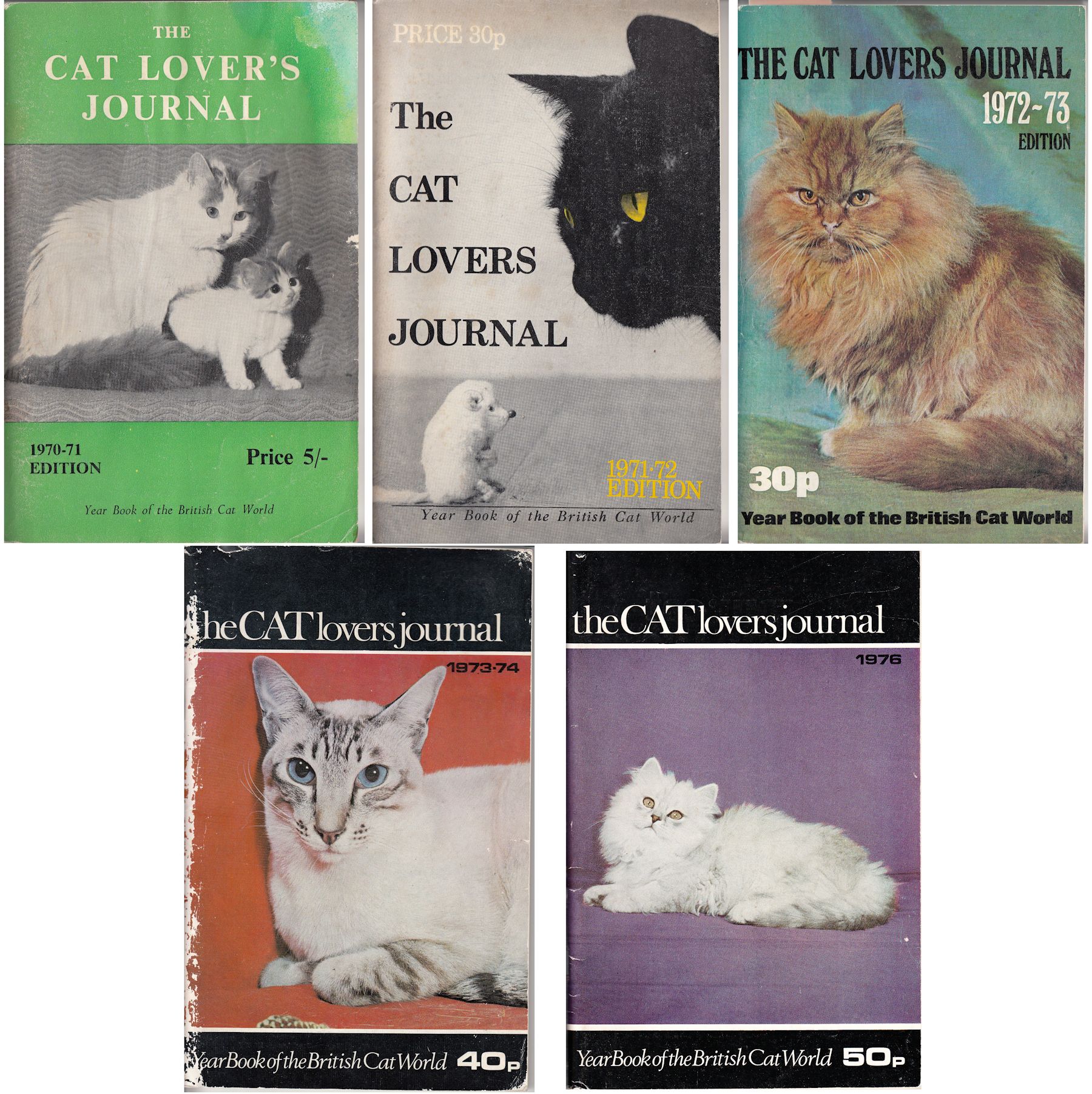
CAT WORLD
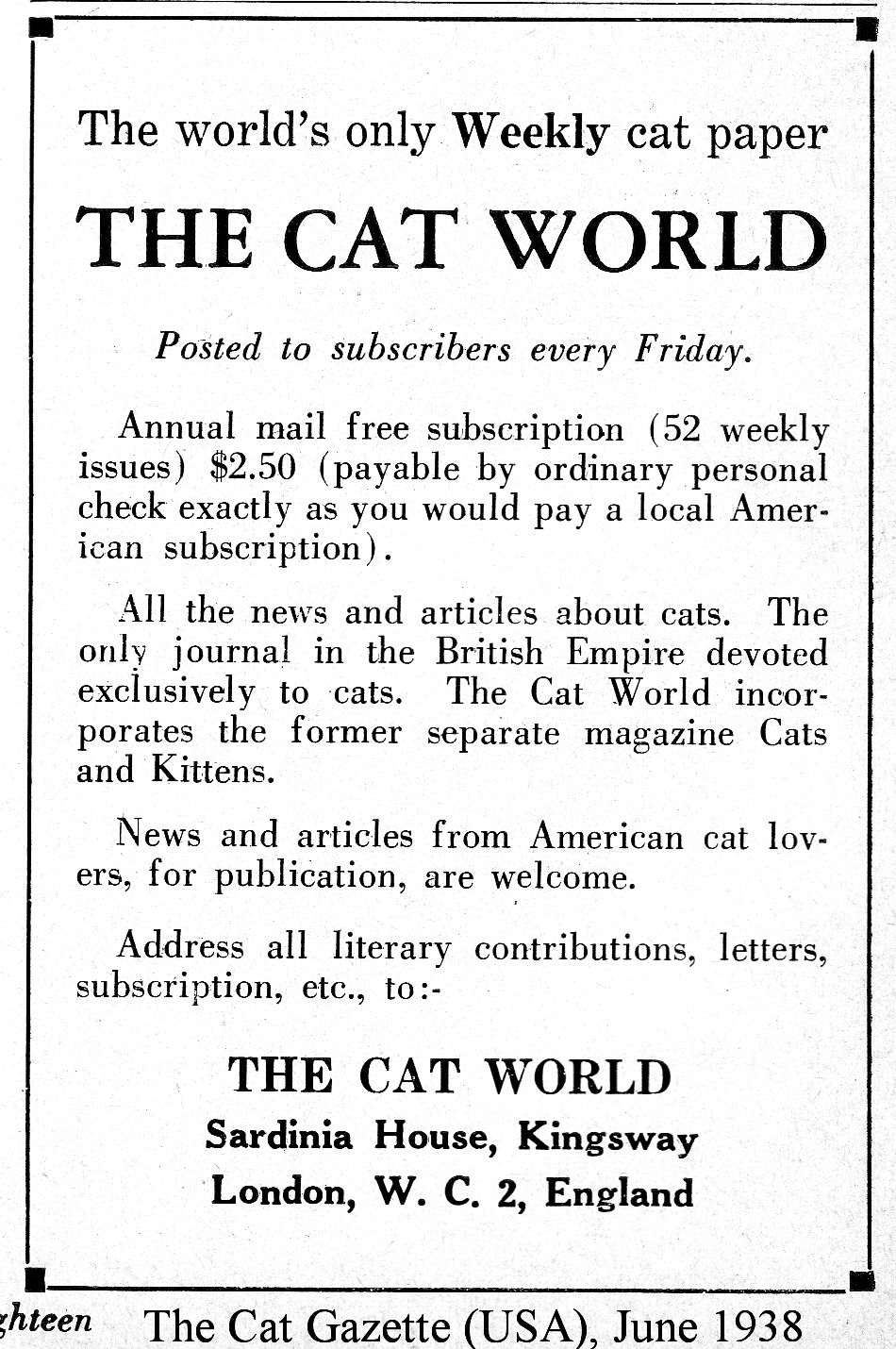
Though now associated with a glossy monthly, there was previously a much earlier weekly of that name. In the 1930s, there was a weekly magazine called The Cat World. It cost two pence and absorbed the the monthly Cats and Kittens magazine. It provided a forum for complaints about the organised cat fancy and a platform for animals charities. The PDSA's first Animal Day was featured in its pages. Many of its articles were reproduced from other cat journals. As war approached, the magazine covered caring for cats in war-time and air-raid precautions. During the war, Cat World vanished, though the name would later be used for a magazine still in circulation.

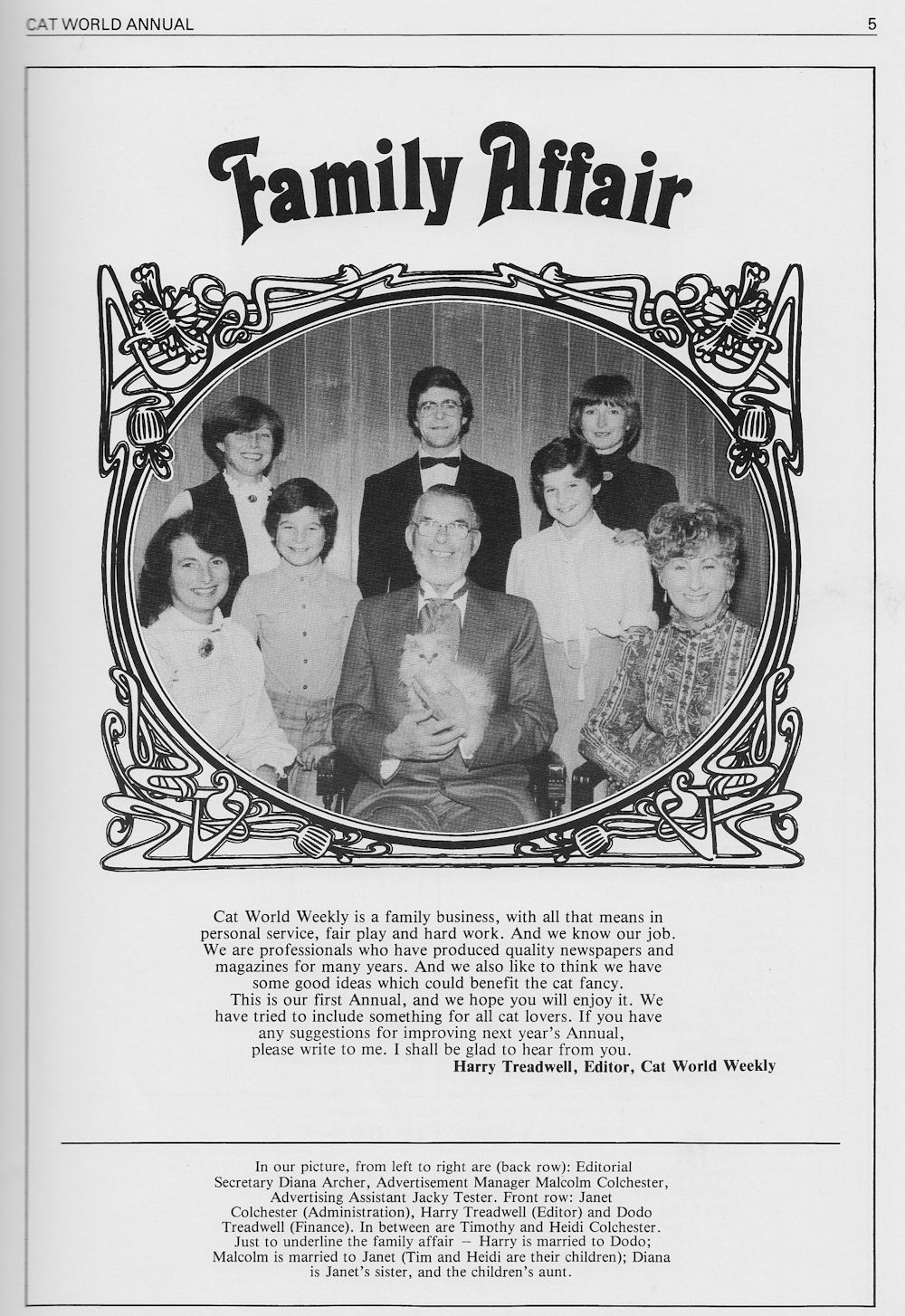
The monthly Cat World is Britain's oldest cat magazine and now caters for breeders, exhibitors, rescuers and for general cat lovers. It began in the early 1980s as a weekly, but became a monthly. Issues during the mid 1980s (where my collection begins) tended to have rather lightweight articles, but in the latter half of the 1980s, content increased and became decidedly meatier with more in-depth articles on health and behaviour, breed profiles and the dates of major shows. There were also plenty of articles submitted by readers. Up until 1997 it also produced a winter annual.
During the late 1980s and early 1990s, it had a slimmer sister publication called "Show World", later renamed "Show Cats". This carried cat show results and commentaries, especially the non-GCCF shows (GCCF shows being amply covered by Cats at that time). Both were produced by Cat World Ltd.
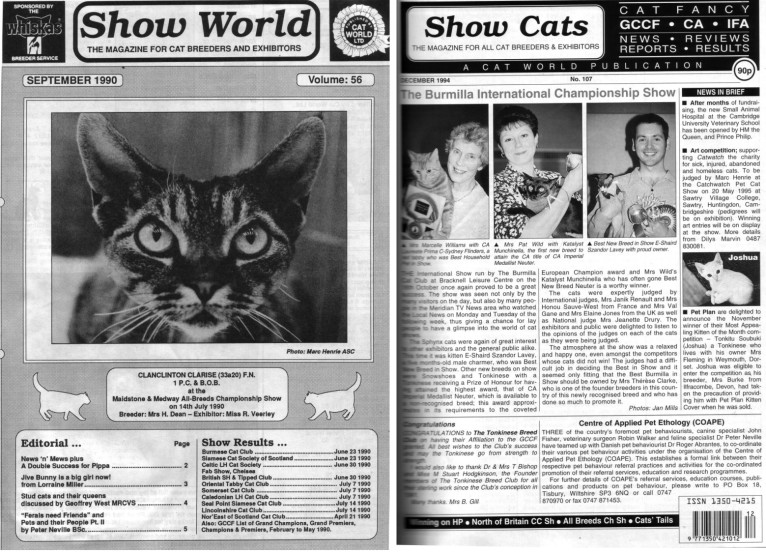
In the early 1990s Cat World contained a quarterly pull-out section called Paws that contained lighter-hearted articles and almost no advertising. In the mid 1990s it suffered a decline in an increasingly competitive market and was updated and reformatted. Show Cats ceased being a separate publication and was incorporated as a pull-out section of Cat World. At the end of 1996 it was apparently in dire straits, issues were not appearing on time and its stand was missing from the 1996 Supreme Show (October). It was bought by Ashdown Publishing and a December issue finally appeared, though the January 1997 issue was never produced. The absence of the Jan 1997 issue continues to perplex collectors who subscribed after that date!
The following message (a re-posted email from Ashdown Publishing) appeared on rec.pets.cats on Dec 16th 1996
"Thank you for coming to speak to us [Cat World] at our stand at Olympia on Saturday. I would be grateful if you could post the following information to the newsgroups rec.pets.cats and alt.animals.felines.
Cat World has just been taken over by Ashdown Publishing. Ashdown are a thriving independent publishing company with more than 16 years experience in producing specialist magazines. Our stable of titles includes Dolls House World, Teddy Bear Times and Doll Magazine. They are all leading magazines in their field, and sell throughout the UK as well as all over the world.
As a company we are committed to the long-term development of Cat World, and will ensure it retains its well-deserved reputation as 'Britain's best-loved Cat magazine.' The presses have been rolling throughout the night to ensure the latest issue was produced in time for the Olympia Show. Shops and subscribers will be receiving the December issue during the course of the coming week. The next issue is already well underway and will be out early January [1997]."

Though perhaps no longer Britain's biggest selling cat magazine (that honour may have gone to Your Cat) it is the longest-established, however in 2020 it became an online publication only and seems to have vanished in Octobe 2020 as it was no longer offered on the Ashdown Publishing website (this was the yaer of the Covid-19 pandemic and many businesses collapsed).
ALL ABOUT CATS
First published in March 1994, this was the British version of the French Atout Chats/ German Geliebte Katze magazine and was initially edited by former Cat World editor Grace McHattie (1994/5). It was aimed at a more general audience, but was launched at almost the same time as Your Cat. It was quite obvious that (too) much of its content had originated from the French or German versions.
In 1996 it produced its one and only annual, following the tradition of the longer established Cat World magazine.
At the start of its life, its less-than-glossy appearance, thinner paper and often poor-quality images gave it a more down-market look compared to Cat World and Your Cat. After a couple of years, competitions that were supposed to spread over several months tended to be halted and left unfinished (perhaps due to lack of interest or lack of sponsorship revenue) - as friends and I discovered from personal experiences. It changed from monthly to bi-monthly and revamped its image with better quality paper, but the change of image came too late and it ultimately vanished after the June/July 2001 issue.

It is not to be confused with the South African glossy bi-monthly of the same name.
YOUR CAT
This glossy full-colour monthly magazine was launched as a bi-monthly in May/June 1994, around the same timeframe as All About Cats. In March 1995 it went monthly. After All About Cats ceased publication, it went head-to-head with older rival Cat World and covers similar ground with the addition of a larger "Ask the Experts" section and a monthly fiction spread. So far, it hasn't suffered the ups and downs that have beset its main rival.
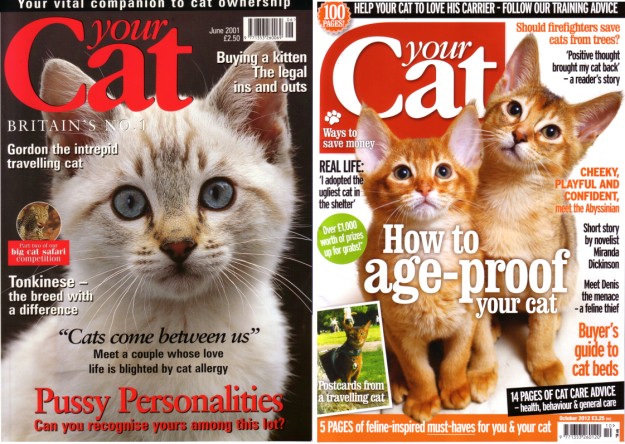
CATS TODAY
This short-lived glossy bi-monthly began in Oct/Nov 2000 and aimed to be a non-cutesy magazine that would appeal to both genders. This was a refreshing take on cat magazines. However, the Dec 2001/Jan 2002 issue, though promoted in the Oct/Nov 2001 issue, did not appear and it ceased publication after only a year.
Although it aimed at a different niche from other news-stand cat magazines, that sector could not sustain 4 titles. Cats Today, along with All About Cats, were the two casualties.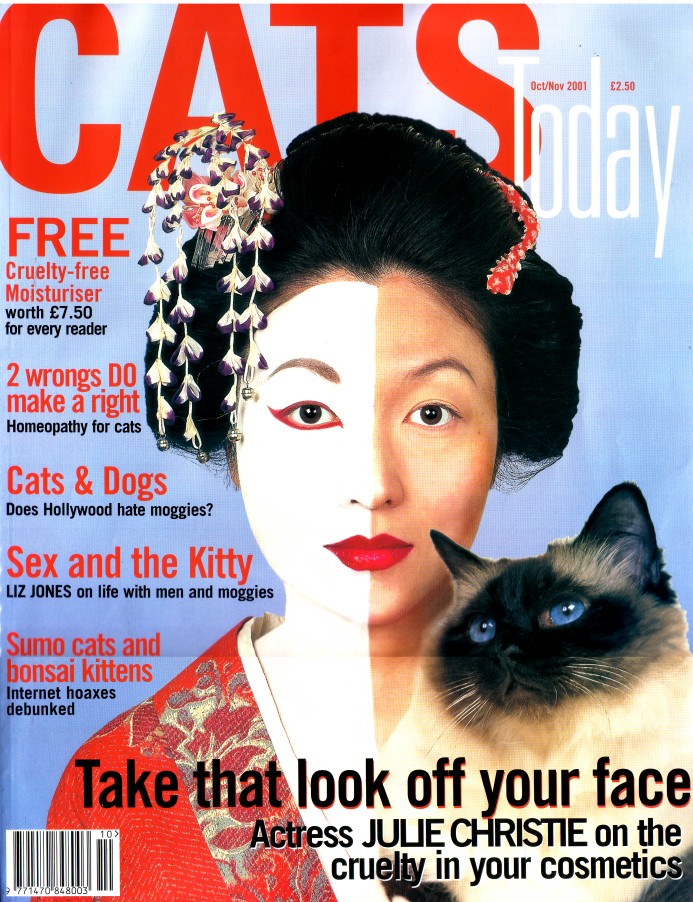
THE CAT
"The Cat" is published by the charity Cats Protection. In 1927, this charity was founded under the name "The Cats Protection League" and set out to be set out to be an educational body, rather than a rescue society. In 1931, it began publishing The Cats' Mews Sheet (price 1d), a four-page, black-and-white A5 newsletter edited by Miss Jessey Wade. This membership magazine originally aimed to educate and provide a forum for suggestions, questions and answers, and also to gain the co-operation of other animal societies of the time. The Cats Protection League's news-sheet was born during the 1930's Depression and increasing tensions in Europe that would lead to the Second World War. The first 51 issues of The Cats Mews Sheet were edited by Cats Protection founder Jessey Wade, but by 1934 it was running at a loss, forcing its first significant changes. It was successfully relaunched in January 1934, with its name shortened to "The Cat", and expanded to eight A5 pages (i.e. 2 sheets folded A4) to include a cover image, more articles and advertising. The first advert (Feb 1934) was for Spratt's New Ready-For-Use Cat Food. The price was raised to 2d. Jessey Wade remained the editor until March 1935. By early wartime in 1939, The Cat followed the nation's motto to "Keep Calm and Carry On" albeit at a reduced size and with no photographs in order to minimise printing costs. Instead of photos, it carried a few line drawings to break up the text. It was edited by Mrs Avery. During wartime, it didn't miss a single issue and it carried advice for cat owners on feeding and caring for cats during the rationing and shortages. At the end of this period, The Cat carried an account of its achievements done by a skeleton staff of three people - during wartime. In 1945, The Cat reinstated its cover image and the celebratory heading of The Victory Cat'. Due to ongoing shortages, it continued to be an A5 publication illustrated with a few black-and-white photos and line drawings (it would remain in this form until the end of 1974). In 1951, to further reduce printing costs it cut back to 10 issues per year instead of being monthly.
In 1955, The Cat, now edited by Osyth Sherratt, celebrated its 21st anniversary and included excerpts from the writings of cat-loving film star James Mason. It also carried an article from a cat rescue in Victoria, British Columbia. Celebrity articles and overseas rescue articles would become regular features half a century later! In 1962, Albert Steward took over as editor and in 1967, the Cats Protection League celebrated its 40th Anniversary and the June issue of The Cat, edited by Albert Steward, was its celebration issue. By then, many other cat magazines had gone out of print and The Cat proudly referred to itself as "The oldest magazine devoted entirely to cats and their welfare". In that issue Steward wrote of the other publications "Other cat magazines have come and gone, creating considerable impressions and advocating the cause of our feline friends in their respective ways. We recall Our Cats' and Cat Gossip' early in 1900 period. 'Cats and Kittens' and The Cats World' 1930's and Our Cats' of recent years but now alas out of circulation."
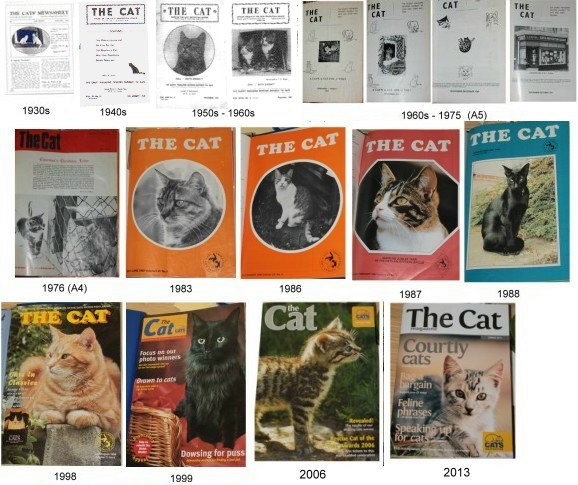
In 1969, The Cat expanded in size, but cut its frequency to 6 issues per year to prevent the annual subscription being increased. Albert Steward retired as editor after the March/April 1972 issue. The Jan/Feb 1972 issue was the first A4 issue and the first to have a colour cover. Its circulation also increased and at the end of the 1970s, members' cats were featured on the cover. In the 1980s, it introduced a page for younger supporters.
In the mid-1990s, the magazine reintroduced general features. General features had not been widely included since before Second World War. It still carried news from Cats Protection branches and adoption centres, but instead of including branch news from every branch in every issue, each issue concentrated on one region only (plus homing appeals from other regions). The mix of articles included feline welfare in other countries, and regular articles about cat-themed postage stamps. It also introduced regular articles about medical conditions and cat behaviour issues contributed by experts. In Spring 2008, The Cat became a glossy-covered magazine and was, by now, a quarterly. In 2011, it celebrated its eightieth birthday and introduced regular interviews with cat-owning celebrities, reflecting the public's insatiable interest in the lives of celebs.
FAB / CAT CARE
The Feline Advisory Bureau was founded in 1958 to gather information about medical and behaviour aspects of cats. The information was published in the FAB Bulletin. In 1992, this expanded and became the Feline Advisory Bureau Journal. Over the years this moved away from specialised subjects and became more of a magazine. In 1996, it spawned a sister publication for the more specialised feline surgery and medicine content. In 2008, the FAB Journal became "Cat Care". During the 21st century, the Feline Advisory Bureau had become an international entity and changed its name, and that of its journal, to International Cat Care.
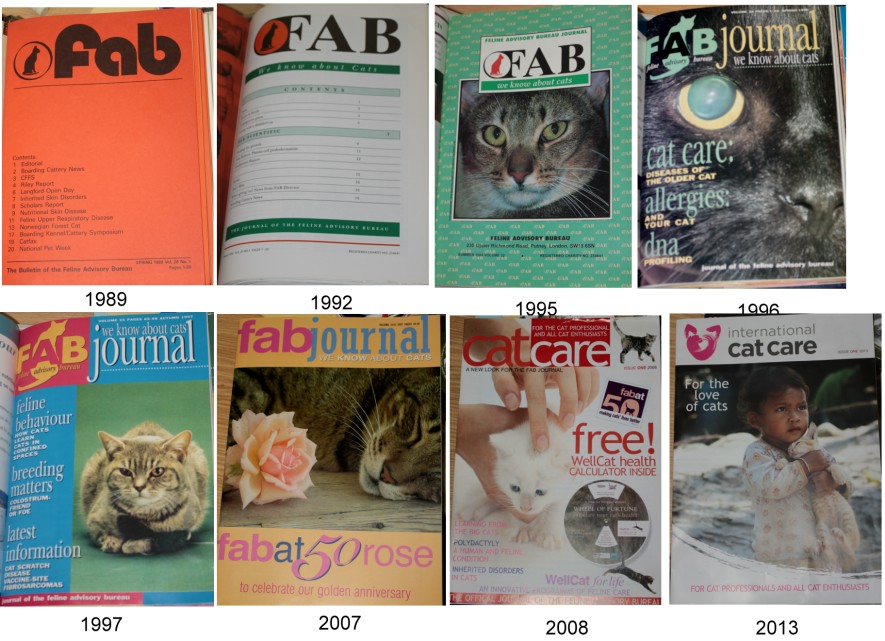
Cover images are copyright of their respective publisher and reproduced for the purpose of review and education only.